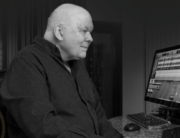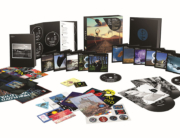BY MIKE METTLER – NOVEMBER 18, 2016

Angelic viewpoint: Enigma in repose. Photo by Jim Rakete.
When composer/producer Enigma dropped MCMXC a.D. in 1990, he literally turned the electronic music genre on its ear with his innovative use of Gregorian chants on “Sadeness (Part I),” an international dance smash that featured vocals in both Latin and French. That, coupled with the far-reaching impact of tracks like 1993’s “Return to Innocence,” which sported a Taiwanese chant and a sample of John Bonham’s signature drum beat from Led Zeppelin’s “When the Levee Breaks,” all helped propel Enigma to sales of over 70 million albums worldwide to date — not to mention hundreds of millions of overall views on YouTube.
After an eight-year absence filled with only “MMX The Social Song,” a single in 2010 created with the help of his fanbase, Enigma has returned with the broad electronic strokes of his eighth album, The Fall of a Rebel Angel (Republic). Over on Digital Trends, Enigma and I discussed how he creates his vast personal sound library, how “Sadeness” got “resolved” 25 years later, and how tension is key to the musical journey.
Exclusive to The SoundBard, Enigma (born Michael Cretu in Bucharest, Romania) and I continue our conversation, this time about the merits of surround sound, the significance of the number 8, and why he feels the vinyl medium is lacking.
Mike Mettler: I love the way you use all of the stereo field on The Fall of a Rebel Angel, because this is very much a headphones album — although I would actually love to hear a 5.1 surround sound mix of a song like “The Omega Point.” Have you thought about doing things in surround sound?
 Enigma: I did it once on Enigma 6 [2006’s A Posteriori], but I’d like to make surround in a completely different way in how to use the music. I came to the conclusion that if you’re not perfectly equipped and not sitting in the exact center position, then you are getting out of phase and losing bass frequencies — and that’s very dangerous.
Enigma: I did it once on Enigma 6 [2006’s A Posteriori], but I’d like to make surround in a completely different way in how to use the music. I came to the conclusion that if you’re not perfectly equipped and not sitting in the exact center position, then you are getting out of phase and losing bass frequencies — and that’s very dangerous.
Nowadays, people are listening more and more on headphones or just on their laptops, so for me, it makes not too much sense of doing surround. I prefer to concentrate on stereo, but I try to use all the possibilities of stereo sound. Surround isn’t done properly, I think. Surround sound headphones might be the solution, but they’re not existing all that much yet.
Mettler: DTS has a product called Headphone:X that sends the music around your head in 360 degrees; it’s actually quite amazing. And I happen to think Enigma music is 360 degrees music.
Enigma: If something like that becomes a new standard, then it’s something that I will do. My Merlin [mobile digital studio] workstation can do it, so I can work in surround, yeah.
Mettler: Oh good. To me, a song like “Oxygen Red” is the perfect sound template for that.
Enigma: With all that’s moving around in that mix, you could do a lot of things with that one, I agree; I agree.
Mettler: And the work of some of your featured vocalists — the effect Mark Josher gets with the vocoder on “The Die Is Cast,” for example — you and he had a great collaboration there. But you guys already had some chemistry in your pocket after working on “MMX The Social Song” 5 years ago.
Enigma: Right. “The Social Song” was done to celebrate 20 years of Enigma, and his was one of the voices voted upon. I liked his voice and his approach to music, and I told him, “When I do new Enigma music, I will think of you.” And I think I found the right song for him.
I also got to work with Anggun, one of my favorite vocalists for many years. I knew she would be able to do exactly what I had in my mind.
Mettler: Especially on “Mother,” she was hauntingly effective.
Enigma: Yes — and she had never spoken on a record before in her life! But she was amazed, and amazing. It’s an amazing track. It’s got some mystery and some thrill and it’s sexy, and everything. And she also has a brilliant vocal on the end of “Sadeness (Part II).”
Mettler: You didn’t originally intend to have Anggun on three songs, right? It just naturally worked out that way.
Enigma: Yeah, there are three. It was developing. When I asked her if she wanted to be a part of the album, she was very excited, because she told me from the very first day she was an Enigma fan. Then she came into my studio to work, and I tried to explain what I wanted to do and what the intention of the new album was, but without any of the songs written yet — just testing in the studio with some patterns, and the range of her voice. I asked her to speak a little something because I had no idea if it would sound any good but it did, and I knew we would have a very good way of working together.
After having all this information, I started to build the songs for the album, and in the back of my mind, having her as the singer. And then she came here to my studio, and she was very happy about the songs. After finishing “Sadeness” with her on the last part, I said to her, “I have to do another song with you and your voice, because I would like to hear your voice on another song.”
And so I rewrote “Oxygen Red” completely so that it would fit her. That’s why she is on three songs on the album.

Visualness: Enigma, seated at left, alongside Wolfgang Beltracchi, who painted the cover art for The Fall of a Rebel Angel, as well as the individual interpretations of each of the album’s 12 songs. Photo by Jim Rakete.
Mettler: She has what I call the underwater vocal at the beginning of “Oxygen Red,” before it begins to morph and change into different-sounding shapes.
Enigma: Yes, because I’m working with, as you mentioned before, EQs and delays, and pitching down things, and then up. I tell you, it’s nothing done by purpose — I’m trying to experiment with things until I’m happy with the result.
You get a moment where you feel it is exactly how it should be. I feel it, and then I’m happy with it — all the delays and reverbs, and all this atmosphere.
Mettler: When I got to the end of this 45-minute journey, I started it right back up again, because I get so many rewards out of repeat listenings. There are so many other layers to discover the next time or times you go through it. “Diving,” for example, is a nice counterpoint that follows “The Omega Point.” And the sequencing is critical here, because “The Omega Point” is so intense, and “Diving” pulls you back a bit before we go into the next phase.
Enigma: Exactly, exactly. “Diving” is at the right point in the story before going into “The Die Is Cast.” I didn’t want that song coming right after “The Omega Point” because there would have been too much energy. At that point, I have to calm down — even me, when I was working on the album, I said I needed that kind of break there. I said to my friend Michael Kunze, we had to write that scene into the story.
Mettler: Another interesting point is about the number eight — if you turn it on its side, it becomes the infinity symbol, which I’m sure ties into some of what you were saying earlier about its importance.
Enigma: Absolutely, absolutely! You have come across what the meaning of eight is. On one point, it was the lucky number for all of Babylonia, the number of Jesus Christ in religion [888]. Even oxygen has the atomic number of eight, which is one of the most important elements for any of us to survive.
It also expresses the idea of the circle being closed, and at the same time, it’s a new beginning. All these meanings of the number eight inspired me musically, and they also inspired Michael Kunze during the process of writing the story.

Happiness, Part II: Enigma. Photo by Jim Rakete.
Mettler: Do you feel the vinyl format is a good way to listen to this album?
Enigma: To be honest, to listen to — no. From the point of view of having something in your hand, vinyl is something that’s more emotional than a download. But for the clarity and sincerity, especially for the kind of music that I’m doing, what you have with the digital is much bigger than with the vinyl. And you know the old story with vinyl — after a few years, the quality is worse and worse.
Mettler: Understood. Well, I’m already looking forward to the next album, number 9. Too early to tell what it will be?
Enigma: My God, I just finished number 8; please! I need a little bit of a break! (both laugh)
Mettler: I just keep hearing The Beatles saying, “number 9… number 9…” in the back of my head, so it’s their own kind of chant for you, I guess. (Enigma laughs) At any rate, thank you for giving us this kind of music to listen to in the highest form possible.
Enigma: (chuckles heartily) Thank you, thank you. With pleasure!






